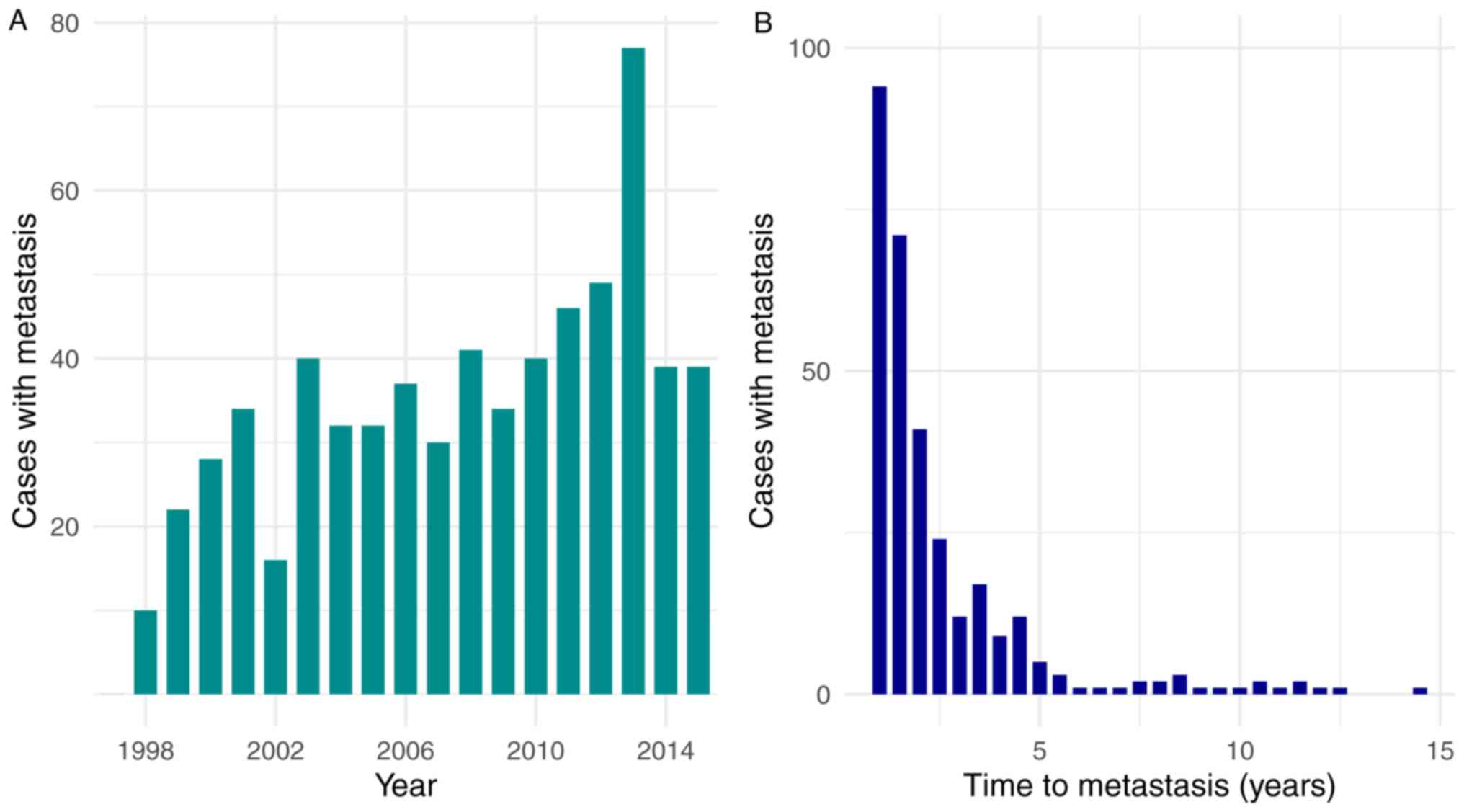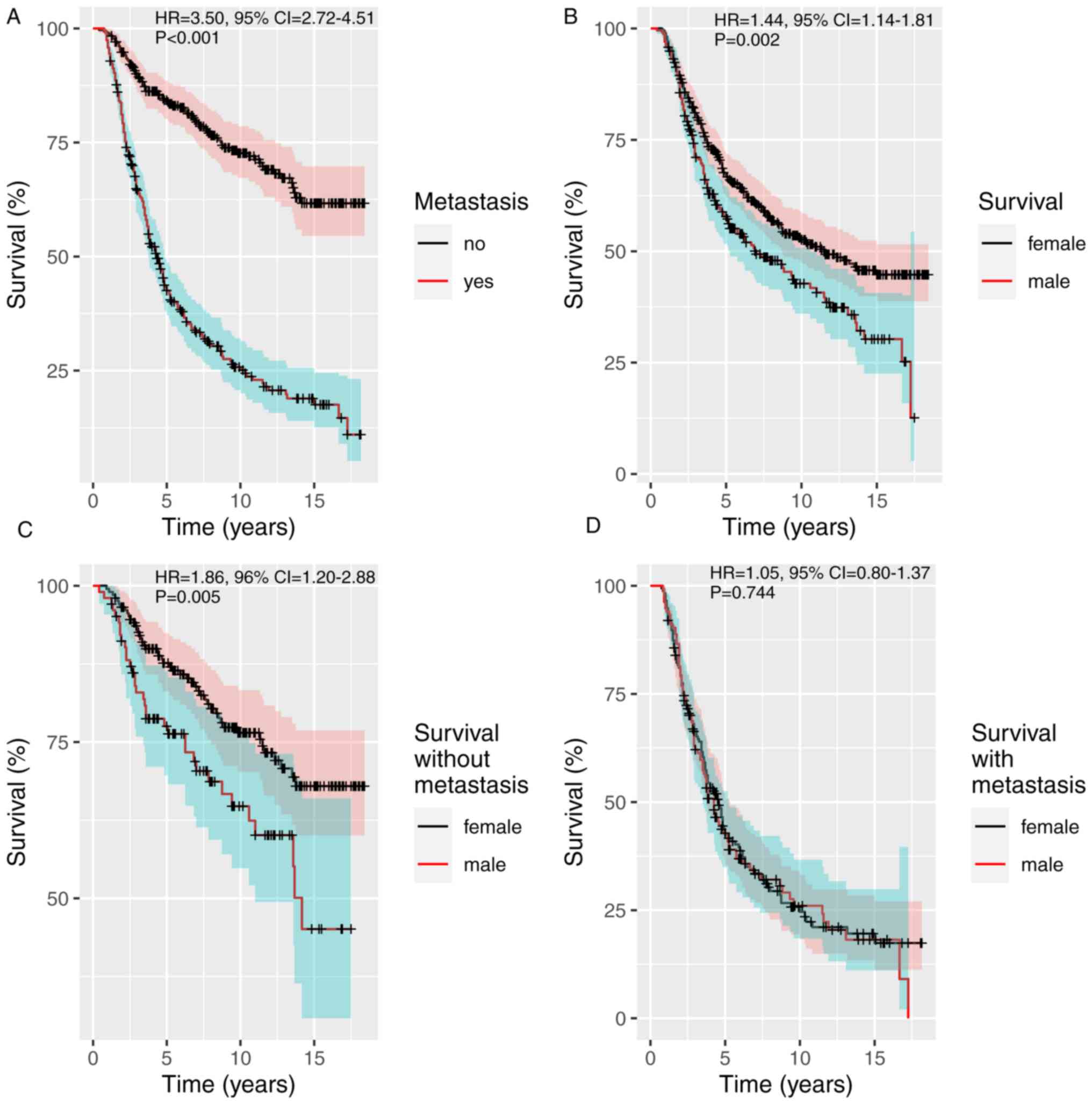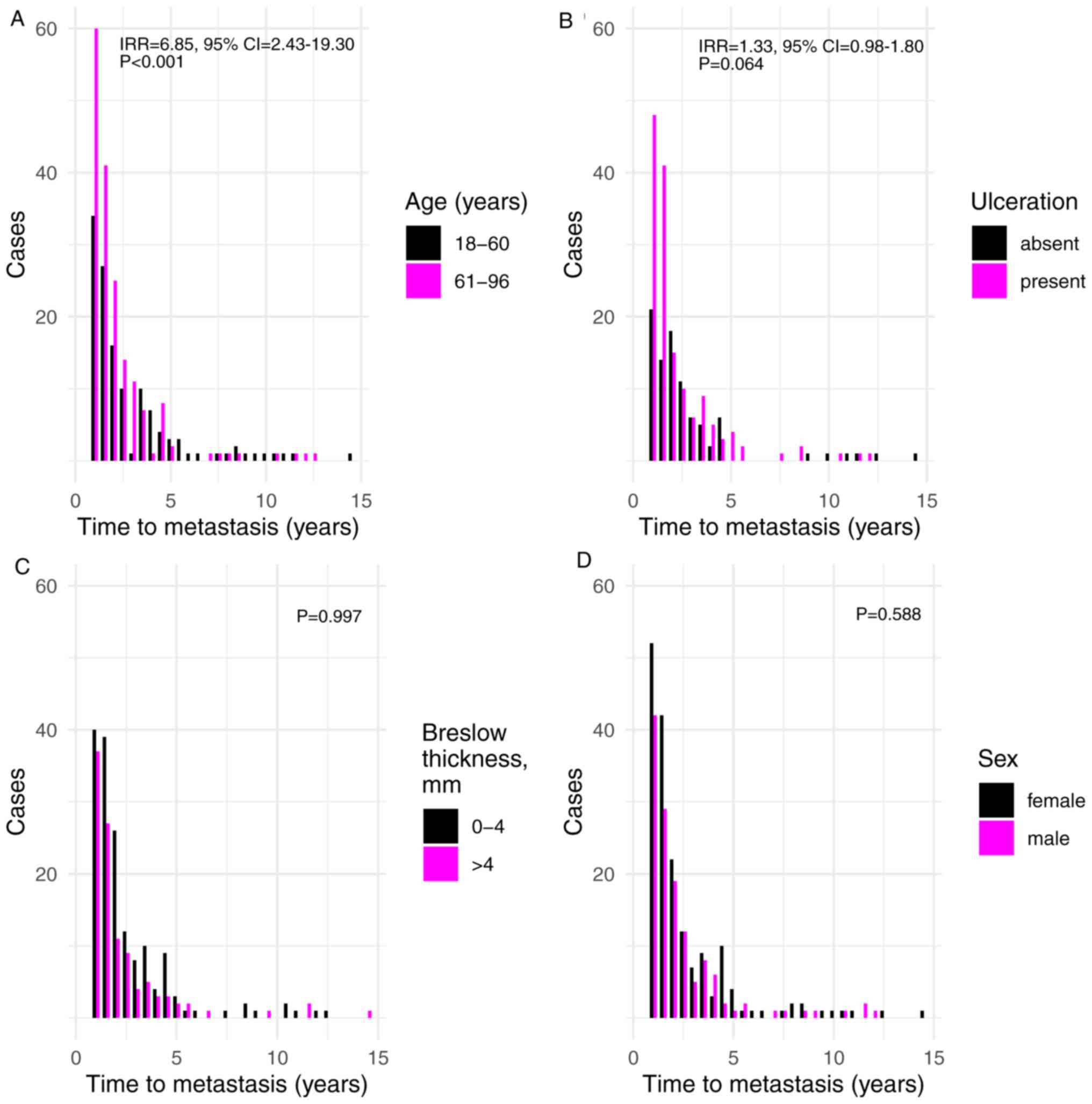|
1
|
Apalla Z, Lallas A, Sotiriou E, Lazaridou
E and Ioannides D: Epidemiological trends in skin cancer. Dermatol
Pract Concept. 7:1–6. 2017. View Article : Google Scholar : PubMed/NCBI
|
|
2
|
SEER*Explorer, . An interactive website
for SEER cancer statistics. Surveillance Research Program, National
Cancer Institute. June
26–2020
|
|
3
|
Lasithiotakis KG, Leiter U, Gorkievicz R,
Eigentler T, Breuninger H, Metzler G, Strobel W and Garbe C: The
incidence and mortality of cutaneous melanoma in southern Germany:
Trends by anatomic site and pathologic characteristics, 1976 to
2003. Cancer. 107:1331–1339. 2006. View Article : Google Scholar : PubMed/NCBI
|
|
4
|
Stang A, Pukkala E, Sankila R, Söderman B
and Hakulinen T: Time trend analysis of the skin melanoma incidence
of Finland from 1953 through 2003 including 16,414 cases. Int J
Cancer. 119:380–384. 2006. View Article : Google Scholar : PubMed/NCBI
|
|
5
|
Azarjana K, Ozola A, Ruklisa D, Cema I,
Rivosh A, Azaryan A and Pjanova D: Melanoma epidemiology, prognosis
and trends in Latvia. J Eur Acad Dermatol Venereol. 27:1352–1359.
2013. View Article : Google Scholar : PubMed/NCBI
|
|
6
|
Shaikh WR, Dusza SW, Weinstock MA,
Oliveria SA, Geller AC and Halpern AC: Melanoma thickness and
survival trends in the United States, 1989–2009. J Natl Cancer
Inst. 108:djv2942015.PubMed/NCBI
|
|
7
|
Whiteman DC, Green AC and Olsen CM: The
growing burden of invasive melanoma: Projections of incidence rates
and numbers of new cases in six susceptible populations through
2031. J Invest Dermatol. 136:1161–1171. 2016. View Article : Google Scholar : PubMed/NCBI
|
|
8
|
Essner R, Lee JH, Wanek LA, Itakura H and
Morton DL: Contemporary surgical treatment of advanced-stage
melanoma. Arch Surg. 139:961–967. 2004. View Article : Google Scholar : PubMed/NCBI
|
|
9
|
Oliaro A, Filosso PL, Bruna MC, Mossetti C
and Ruffini E: Pulmonary metastasectomy for melanoma. J Thorac
Oncol. 5 (6 Suppl 2):S187–S191. 2010. View Article : Google Scholar : PubMed/NCBI
|
|
10
|
Balch CM, Gershenwald JE, Soong SJ,
Thompson JF, Atkins MB, Byrd DR, Buzaid AC, Cochran AJ, Coit DG,
Ding S, et al: Final version of 2009 AJCC melanoma staging and
classification. J Clin Oncol. 27:6199–6206. 2009. View Article : Google Scholar : PubMed/NCBI
|
|
11
|
Gershenwald JE, Scolyer RA, Hess KR,
Sondak VK, Long GV, Ross MI, Lazar AJ, Faries MB, Kirkwood JM,
McArthur GA, et al: Melanoma staging: Evidence-based changes in the
American joint committee on cancer eighth edition cancer staging
manual. CA Cancer J Clin. 67:472–492. 2017. View Article : Google Scholar : PubMed/NCBI
|
|
12
|
Sullivan RJ and Flaherty KT: Resistance to
BRAF-targeted therapy in melanoma. Eur J Cancer. 49:1297–1304.
2013. View Article : Google Scholar : PubMed/NCBI
|
|
13
|
Rizos H, Menzies AM, Pupo GM, Carlino MS,
Fung C, Hyman J, Haydu LE, Mijatov B, Becker TM, Boyd SC, et al:
BRAF inhibitor resistance mechanisms in metastatic melanoma:
Spectrum and clinical impact. Clin Cancer Res. 20:1965–1977. 2014.
View Article : Google Scholar : PubMed/NCBI
|
|
14
|
Vilgelm AE, Johnson DB and Richmond A:
Combinatorial approach to cancer immunotherapy: Strength in
numbers. J Leukoc Biol. 100:275–290. 2016. View Article : Google Scholar : PubMed/NCBI
|
|
15
|
Bhandaru M and Rotte A: Monoclonal
antibodies for the treatment of melanoma: Present and future
strategies. Methods Mol Biol. 1904:83–108. 2019. View Article : Google Scholar : PubMed/NCBI
|
|
16
|
Weiss SA, Wolchok JD and Sznol M:
Immunotherapy of melanoma: Facts and hopes. Clin Cancer Res.
25:5191–5201. 2019. View Article : Google Scholar : PubMed/NCBI
|
|
17
|
Homsi J, Kashani-Sabet M, Messina JL and
Daud A: Cutaneous melanoma: Prognostic factors. Cancer Control.
12:223–229. 2005. View Article : Google Scholar : PubMed/NCBI
|
|
18
|
In 't Hout FE, Haydu LE, Murali R,
Bonenkamp JJ, Thompson JF and Scolyer RA: Prognostic importance of
the extent of ulceration in patients with clinically localized
cutaneous melanoma. Ann Surg. 255:1165–1170. 2012. View Article : Google Scholar : PubMed/NCBI
|
|
19
|
Han D, Zager JS, Shyr Y, Chen H, Berry LD,
Iyengar S, Djulbegovic M, Weber JL, Marzban SS, Sondak VK, et al:
Clinicopathologic predictors of sentinel lymph node metastasis in
thin melanoma. J Clin Oncol. 31:4387–4393. 2013. View Article : Google Scholar : PubMed/NCBI
|
|
20
|
Dummer R, Hauschild A, Lindenblatt N,
Pentheroudakis G and Keilholz U; ESMO Guidelines Committee, :
Cutaneous melanoma: ESMO clinical practice guidelines for
diagnosis, treatment and follow-up. Ann Oncol. 26 (Suppl
5):v126–v132. 2015. View Article : Google Scholar : PubMed/NCBI
|
|
21
|
Elder DE: Melanoma progression. Pathology.
48:147–154. 2016. View Article : Google Scholar : PubMed/NCBI
|
|
22
|
Portelli F, Galli F, Cattaneo L, Cossa M,
De Giorgi V, Forte G, Fraternali Orcioni G, Gianatti A, Indini A,
Labianca A, et al: The prognostic impact of the extent of
ulceration in clinical stage I–II melanoma patients: A multicenter
study of the Italian melanoma intergroup (IMI). Br J Dermatol. Apr
13–2020.(Epub ahead of print). View Article : Google Scholar : PubMed/NCBI
|
|
23
|
Balch CM, Soong SJ, Gershenwald JE,
Thompson JF, Coit DG, Atkins MB, Ding S, Cochran AJ, Eggermont AM,
Flaherty KT, et al: Age as a prognostic factor in patients with
localized melanoma and regional metastases. Ann Surg Oncol.
20:3961–3968. 2013. View Article : Google Scholar : PubMed/NCBI
|
|
24
|
Brauer JA, Wriston CC, Troxel AB,
Elenitsas R, Shin DB, Guerry DP and Ming ME: Characteristics
associated with early and late melanoma metastases. Cancer.
116:415–423. 2010. View Article : Google Scholar : PubMed/NCBI
|
|
25
|
Messeguer F, Agustí-Mejías A, Traves V,
Requena C, Alegre V, Guillén C, Oliver V and Nagore E: Mitotic rate
and subcutaneous involvement are prognostic factors for survival
after recurrence in patients with only locoregional skin metastasis
as the first site of recurrence from cutaneous melanoma. J Eur Acad
Dermatol Venereol. 27:436–441. 2013. View Article : Google Scholar : PubMed/NCBI
|
|
26
|
R Core Team, . R: A language and
environment for statistical computing. Version 3.6.3. R Foundation
for Statistical Computing. (Vienna). 2012.
|
|
27
|
Venables WN and Ripley BD: Modern applied
statistics with S. (Fourth). Springer. (New York, NY). 2002.
View Article : Google Scholar
|
|
28
|
Therneau TM: A package for survival
analysis in S. Version 2.38. 2015.
|
|
29
|
Tang Y, Horikoshi M and Li W: ggfortify:
Unified interface to visualize statistical result of popular R
packages. The R Journal. 8:474–485. 2016. View Article : Google Scholar
|
|
30
|
Horikoshi M and Tang Y: ggfortify: Data
visualization tools for statistical analysis results.
|
|
31
|
Davies JR, Randerson-Moor J, Kukalizch K,
Harland M, Kumar R, Madhusudan S, Nagore E, Hansson J, Höiom V,
Ghiorzo P, et al: Inherited variants in the MC1R gene and survival
from cutaneous melanoma: A BioGenoMEL study. Pigment Cell Melanoma
Res. 25:384–394. 2012. View Article : Google Scholar : PubMed/NCBI
|
|
32
|
Clark WH Jr, From L, Bernardino EA and
Mihm MC: The histogenesis and biologic behavior of primary human
malignant melanomas of the skin. Cancer Res. 29:705–727.
1969.PubMed/NCBI
|
|
33
|
Downing A, Newton-Bishop JA and Forman D:
Recent trends in cutaneous malignant melanoma in the Yorkshire
region of England; incidence, mortality and survival in relation to
stage of disease, 1993–2003. Br J Cancer. 95:91–95. 2006.
View Article : Google Scholar : PubMed/NCBI
|
|
34
|
Lasithiotakis K, Leiter U, Meier F,
Eigentler T, Metzler G, Moehrle M, Breuninger H and Garbe C: Age
and gender are significant independent predictors of survival in
primary cutaneous melanoma. Cancer. 112:1795–1804. 2008. View Article : Google Scholar : PubMed/NCBI
|
|
35
|
de Vries E, Nijsten TE, Visser O,
Bastiaannet E, van Hattem S, Janssen-Heijnen ML and Coebergh JW:
Superior survival of females among 10 538 Dutch melanoma patients
is independent of Breslow thickness, histologic type and tumor
site. Ann Oncol. 19:583–589. 2008. View Article : Google Scholar : PubMed/NCBI
|
|
36
|
Mays MP, Martin RC, Burton A, Ginter B,
Edwards MJ, Reintgen DS, Ross MI, Urist MM, Stromberg AJ, McMasters
KM and Scoggins CR: Should all patients with melanoma between 1 and
2 mm Breslow thickness undergo sentinel lymph node biopsy? Cancer.
116:1535–1544. 2010. View Article : Google Scholar : PubMed/NCBI
|
|
37
|
Balch CM, Soong SJ, Gershenwald JE,
Thompson JF, Reintgen DS, Cascinelli N, Urist M, McMasters KM, Ross
MI, Kirkwood JM, et al: Prognostic factors analysis of 17,600
melanoma patients: Validation of the American joint committee on
cancer melanoma staging system. J Clin Oncol. 19:3622–3634. 2001.
View Article : Google Scholar : PubMed/NCBI
|
|
38
|
Azzola MF, Shaw HM, Thompson JF, Soong SJ,
Scolyer RA, Watson GF, Colman MH and Zhang Y: Tumor mitotic rate is
a more powerful prognostic indicator than ulceration in patients
with primary cutaneous melanoma: An analysis of 3661 patients from
a single center. Cancer. 97:1488–1498. 2003. View Article : Google Scholar : PubMed/NCBI
|
|
39
|
Nagore E, Oliver V, Botella-Estrada R,
Moreno-Picot S, Insa A and Fortea JM: Prognostic factors in
localized invasive cutaneous melanoma: High value of mitotic rate,
vascular invasion and microscopic satellitosis. Melanoma Res.
15:169–177. 2005. View Article : Google Scholar : PubMed/NCBI
|
|
40
|
Scoggins CR, Ross MI, Reintgen DS, Noyes
RD, Goydos JS, Beitsch PD, Urist MM, Ariyan S, Sussman JJ, Edwards
MJ, et al: Gender-related differences in outcome for melanoma
patients. Ann Surg. 243:693–698. 2006. View Article : Google Scholar : PubMed/NCBI
|
|
41
|
Roh MR, Eliades P, Gupta S, Grant-Kels JM
and Tsao H: Cutaneous melanoma in women. Int J Womens Dermatol. 3
(Suppl 1):S11–S15. 2017. View Article : Google Scholar : PubMed/NCBI
|
|
42
|
Joosse A, De Vries E, Van Eijck CH,
Eggermont AM, Nijsten T and Coebergh JW: Reactive oxygen species
and melanoma: An explanation for gender differences in survival?
Pigment Cell Melanoma Res. 23:352–364. 2010. View Article : Google Scholar : PubMed/NCBI
|
|
43
|
Leiter U, Meier F, Schittek B and Garbe C:
The natural course of cutaneous melanoma. J Surg Oncol. 86:172–178.
2004. View Article : Google Scholar : PubMed/NCBI
|
|
44
|
Callender GG, Egger ME, Burton AL,
Scoggins CR, Ross MI, Stromberg AJ, Hagendoorn L, Martin RC II and
McMasters KM: Prognostic implications of anatomic location of
primary cutaneous melanoma of 1 mm or thicker. Am J Surg.
202:659–665. 2011. View Article : Google Scholar : PubMed/NCBI
|
|
45
|
Gordon D, Smedby KE, Schultz I, Olsson H,
Ingvar C, Hansson J and Gillgren P: Sentinel node location in trunk
and extremity melanomas: Uncommon or multiple lymph drainage does
not affect survival. Ann Surg Oncol. 21:3386–3394. 2014. View Article : Google Scholar : PubMed/NCBI
|
|
46
|
Lotz M, Budden T, Furney SJ and Virós A:
Molecular subtype, biological sex and age shape melanoma tumour
evolution. Br J Dermatol. Apr 13–2020.(Online ahead of print).
View Article : Google Scholar : PubMed/NCBI
|
|
47
|
Buljan M, Rajacić N, Vurnek Zivković M,
Blajić I, Kusić Z and Situm M: Epidemiological data on melanoma
from the referral centre in croatia (2002–2007). Coll Antropol. 32
(Suppl 2):S47–S51. 2008.
|

















